Best Chicken Breeds for Eggs, Meat and Dual Purpose Varieties with PhotosAn information guide to good egg laying chicken breeds available with images for your homestead and backyard. See which of the best laying hens and chickens are right for you.
3 MAIN TYPES OF CHICKENS: Hybrids, Pure-Breeds and Bantams
There are so many types of laying chickens out there that it is understandably overwhelming when you first set out to get some backyard chickens as egg layers. However, they can be broken down into 3 simple types:
1) Hybrid Chickens - The majority of commercial birds are of hybrid stock. These being a cross between a number of different chicken breeds. They are hardy and less susceptible to diseases and some of the best egg laying chicken breeds can be found in this type of fowl.
2) Pure Breeds - Many of these are of old heritage chicken breeds are bred down through generations. Heritage chicken breeds are ideal if you are going to exhibit your birds. They are also ideal if you want to ensure the future of pure bred birds that have been bred for certain qualities that you will enjoy, whether it be for egg-laying or for meat production.
3) There is another type of chicken - Bantam Chickens which are in a class on their own, and ideal to keep when you don't have a lot of space as they are much smaller than the ones mentioned above. However, besides true bantams, there are also many large breeds of chickens which have been bred to become bantam chickens in size. Of these hybrid and pure bred chickens, there are those that are good as egg layers, those that are good table birds for meat production, those that are just pretty to look at, and those that are dual-purpose; good for both eggs and meat.
3 Classes of Chicken Breeds
What makes up hybrids, pure breeds and bantams are 3 main classes of chickens:
- American Class of Chickens
- Asiatic Class of Chickens
- Mediterranean Class of Chickens
American Class
The main American chicken breeds are:Rhode Island Reds are excellent egg-layers and Plymouth Rocks lay large, brown eggs.
However, besides these, there are also the Javas and the American Dominiques. Both these breeds are very old and are America's oldest breeds of chickens.
The Java chickens are similar to the Plymouth Rocks in size, shape and traits. The American Dominiques are the oldest American breed and it was from this breed that the Plymouth Rock originated. Asiatic Class
The main Asiatic breeds are large, solid birds, quiet birds that make very good chickens for pets because of their docile natures. However, primarily the Asiatic birds, because of their large size are reared as meat chickens:Brahmas are the largest of the breeds, docile birds that don't wander off, and their weight means that they don't fly too far. Brahmas are excellent broilers and also lay a large number of large, brown eggs.Cochins have been bred for their size and there are several varieties such as the Buff Cochin, Partridge Cochin, Black Cochin and White Cochin. They are not great egg layers.
Langshams, both black and white were introduced into America, and again are large, docile birds bred for their meat.Mediterranean Class
The Leghorns are the best breed from the Mediterranean class for eggs, and in fact, the best layers around at the moment. Other than the Leghorns there are other types:- Black and White Minorcas
- Andalusians
- Anconas
- Whitefaced Black Spanish
Chicken Breeds for Meat
If you are only interested in breeds of chicken for eating then you should be looking at: - Brahmas
- Jersey Giants
- Langshams
- Cochins
However, this list is not limited to these meat breeds as you will see below. But these are just some of the more popular chicken breeds for meat.
Here is a list of both hybrid meat chickens and old breed and crossed meat chickens
Modern Hybrid Meat Chickens
* White Feathered Cobb
* Shaver Starbro
* Marshall
* Arbor Acre broiler
* Red Feathered Shaver Redbro
* ISA 657 Red-feathered broiler
Old Breeds and Crosses
* Whited feathered White Sussex
* White Cornish
* Red feathered Dorking
* Indian Game
* Rhode Island Red x Light Sussex
* Light Sussex x Indian Game (or vice versa)
* Plymouth Rock
Chicken Breeds for Eggs
If you are only interested in keeping chickens for eggs, then you should be looking at the following chicken breeds:- Leghorns
- Spanish
- Minorcas
- Anconas
- Andulusians
Chicken Breeds for Meat and Eggs
Finally, if you want to keep chickens for both meat and eggs then you should be looking at keeping:- Rhode Island Reds
- Plymouth Rocks
- Orpingtons
- Wyandottes
My Opinion on the Best Chicken Breeds for Eggs
As far as I am concerned, the best chicken laying breeds are by far the White Leghorns , the Plymouth Rocks, and the Rhode Island Reds.
In the past I have kept Rhode Island Reds crossed with Light Sussex and they are excellent layers too producing eggs 6 days out of 7 during the laying season.
They did go off the boil for a while when a lot of them were broody, but eventually they sorted themselves out and went back to laying eggs once again. However, this is one disadvantage of Rhode Island Reds crossed with Light Sussex - they do tend to go broody more than other laying hens.
If you want to your hens to raise their own chicks, then this chicken breed would be the perfect mother. However, if you are just keeping laying hens for eggs, then you may want to look at Leghorns crossed with Rhode Island Reds, or pure Leghorns.
If you are looking for good laying hens in general, trying to decide on the best chicken breed for you. There are plenty to choose from, as you will see from the list below, and although pure bred chickens, in the main, are pretty to look at, mixed-breeds are more hardy, and often very good layers for the backyard chicken keeper.
However, having said all that, not all chicken breeds lay at the same time throughout the year and it is better to keep two breeds that will give you a good supply all year round.
Many chicken keepers will keep Leghorns as their main flock, but then they will also keep American breeds of chicken as well. This is because American chicken breeds will often lay throughout the winter, while the Leghorns won't. During the summer, the Leghorns are better layers than the American breeds.
Plymouth Rocks, although good layers, only out produce Leghorns in March. However, because they are hardy birds they lay well during winter. The Wyandottes produce more eggs during December, January, September, and October.
The Rhode Island Reds lay well in January through to April, but during November, May, June, July, and August, the Leghorns usually outlay all their competitors.
Finally, on a personal level, I thought I would mention ISA Browns. They are not a chicken breed, but rather a hybrid chicken. They are excellent chicken layers of brown eggs that are often the choice of chicken used by egg farms.
I have just acquired 2 of late, and are impressed with their performance. They are said to lay 300 eggs a year. The only downside is, that because the ISA Brown is such an egg-laying machine, they have a very short lifespan. However, I am hoping to beat this by keeping up their protein levels. We shall see. I also keep Plymouth Barred Rocks as they are an excellent dual purpose bird that do well in cold weather. And we also have Columbian Rocks.
Basically, if you want to keep chickens for eggs, you really have to keep a number of different chicken breeds that will produce eggs for you over the year, because you will find that when one type is not laying as well, the other varieties are.
So you can see that keeping a number of different chicken breeds for eggs would make far more sense, than just having one type of chicken.
However, I do have to add, that if you don't get your hens to lay by September or October after they have moulted, they probably won't lay again until the following spring.
As a result you will find that some breeders force their hens into moulting by reducing the grain drastically from mid-July through to mid-August, giving the hens only enough grain to keep them alive. After that, they are then given lots of grain and lots of sunflower seeds.
This seems to result in a total loss of feathers almost all at once. However, a month later, by mid-September the hens are through their moulting and laying again.
Here is one of my ISA Brown hens, along with my Plymouth Barred Rocks.
My personal pick for good laying hens is any of the following 4 chicken breeds that are cross-bred with each other:
- White Leghorns
- Rhode Island Reds
- Light Sussex
- White Wyandottes
Rhode Island Reds, crossed with White Wyandottes makes another excellent cross-breed for chickens.
Cross-Breeding Chickens for Eggs and Sex-Linking
If you are going to go into cross-breeding chickens, you need to know what the off-spring will look like.
If you mate a Rhode Island cockerel with a Light Sussex hen the male chicks will be white in color, like the hen, and the female chicks will be reddish brown, like the father. This is called "sex-linking" in chickens and makes identifying the sexes easier.
If you mate a Rhode Island cockerel with a White Wyandotte hen, you will again get the same result where the female chicks are reddish brown, and the male chicks are white. The offspring of this mix, makes better layers than those crossed with a Light Sussex.
You will not be able to sex-link chicks if you have a light colored cock, such as a White Leghorn and mate it with a Rhode Island hen, for example.
However, sex-linking can be done with mixed-bred chicks in a following generation, if you mated a Rhode Island Red cockerel with a hybrid that was the result of a mating of a Rhode Island Red cockerel with a White Leghorn, for example.
Chicken Breeds that Lay Brown Eggs
Despite the fact that there is no nutritional difference in both brown and white eggs, many people want chickens that lay brown eggs.
There are many hybrid breeds as well as pure breeds or first crosses that lay brown eggs, and I thought I would list them here for you, as on overview.
Hybrid Layers of Brown Eggs
* ISA Brown
* Hisex Brown
* Shaver Brown
* Hy-Line Brown
* Babcock Brown
* Ross Brown
* Hubbard Golden Comet
Pure Breed Chicken Layers of Brown Eggs
* Maran
* Rhode Island Red
* Barred Plymouth Rock
* Black Rock
* Rhode Island Red x Light Sussex
* Dorset
* Wellsummer
GOOD EGG LAYING CHICKEN BREEDS: BEST EGG LAYERS

LEGHORN CHICKEN BREEDS
These are probably the best laying chickens around, besides the Rhode Island Breeds. They are prolific egg layers of white eggs. A small, spritely, noisy bird with great style, that like to move about. Leghorns are good foragers and can often glean much of their diet from ranging over fields and barnyards. Leghorns are capable of considerable flight and often roost in trees if given the opportunity. Leghorns lay more than 300 eggs a year.
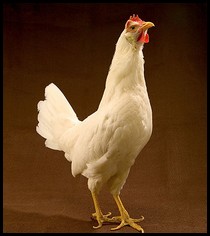 Very flighty
Good foragers
Rarely Broody |
AUSTRALORP CHICKEN BREEDS
An Australian bird developed from the Orpington chicken. Black feathers with a green sheen. Can lay from as early as 5 months. Australorps lays about 300 eggs a year, so another good layer for chicken eggs.
Dual Purpose
Hardy
Good Choice for Novice Breeder |
ORPINGTON CHICKEN BREEDS
Originally from England. This is a heavy set bird and because of its size is not flighty. Orpingtons are lovely, docile birds and therefore make excellent chickens as pets as well as a breed for the novice chicken keeper. Orpingtons lay 220 - 240 eggs a year, making it another good breed for egg layers. 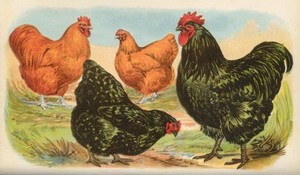
Broody
Gentle
Ideal for the novice
|
LIGHT SUSSEX CHICKEN BREEDS
The Sussex is an attractive little bird and makes a good all-round farm fowl. It is a good layer of cream eggs. 260-280 eggs per year. So not a bad egg layer. Best Dual Purpose Bird
Good Foragers
Tend to go Broody |
RHODE ISLAND RED CHICKEN BREEDS
The Rhode Island Red Chickens are prolific egg layers of medium brown eggs. Relatively hardy, they are probably the best egg layers of the dual purpose breeds. Reds handle marginal diets and poor housing conditions better than other breeds and still continue to produce eggs. 200-250 eggs a year.Dual Purpose Bird
Hardy
Good Choice for Novice Breeder |
ANCONA CHICKEN BREEDS
Italian breed of chicken, originating from the town Ancona. Black with white-tipped feathers. Laying chickens of large white eggs; 220 - 240 a year.
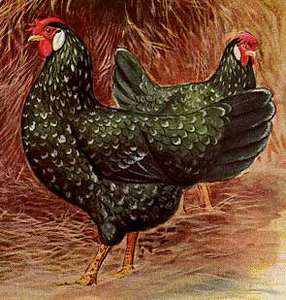
Very flighty
Broody
Gentle
|
|
HAMBURG CHICKEN BREEDS
Originally from Holland, despite its name. Active and flighty chickens that are considered good laying hens, laying 200 - 220 small white eggs every year. Several varieties including Silver Spangled Hamburgs, Golden Spangled Hamburgs, Gold- Pencilled and Silver-Pencilled.
Active
Very flighty and need wings clipped |
HOUDAN CHICKEN BREEDS
A striking bird, originally from France. It has a crest, beard and muffs and has 5 toes. 200-220 eggs per year, so making these average laying hens.
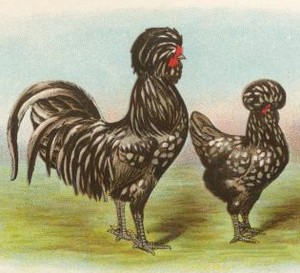
Exhibition Bird
|
MINORCA CHICKEN BREEDS
Originally from Spain. This ancient chicken, known to the Romans lays about 220-240 large white eggs every year during productivity. So good laying hens that are hardy and good foragers for their food. The most common color is black, but you get white, buff and blue Minorca chickens too. Large combs and wattles. Developed for the production of very large chalk-white eggs, the Minorca is today principally an exhibition fowl.
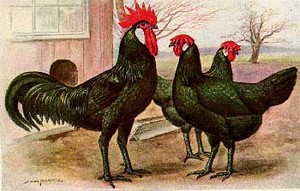
Good Foragers
Alert
Rarely go Broody |
ARAUCUNA CHICKEN BREEDS The Araucuna is a South American bird that is rumpless and a producer of medium-sized blue/green eggs. Lays 180-200 eggs a year. So good laying chickens and a good layer for those unusually colored eggs. It is the only chicken breed to lay colored eggs of red, blue or green.
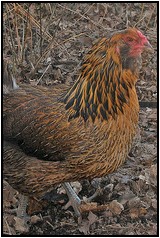
Dual Purpose
Hardy
Good Choice for Novice Breeder |
BARNVELDER CHICKEN BREEDS
A quiet and often lazy little bird that lays 180-200 light brown eggs a year. Originally from the town of Barnvelder in Holland, it is the most popular dual purpose chicken in this country. Good chicken for damp and cold, windy climates.
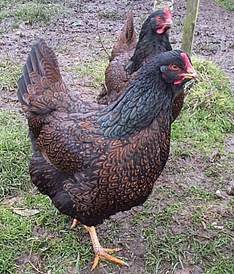
Good Dual Purpose Bird
Docile
Hardy |
INDIAN GAME FOWL
Also known as Cornish chickens. Originally from Cornwall. Not good egg layers; 160-180 eggs a year. Kept for meat purposes as it has a well muscled body, but also needs substantial amounts of food.
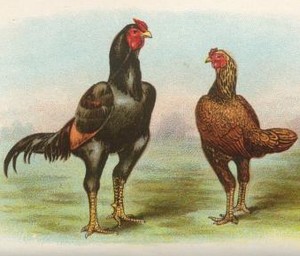
Broody
Meat Chicken
Prone to mite infestations |
PENEDESENCA CHICKEN BREEDS
The Penedesenca, once close to extinction in the 80s but now only semi-rare. The Penedesenca has white ear lobes but lays deep red-brown eggs with a sheen to them. 160-180 eggs a year.
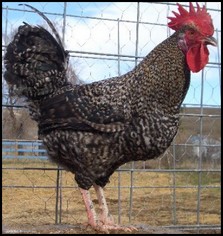
Gentle if hand-raised.
Black Penedesenca are Dual Purpose
|
PLYMOUTH ROCK
An American breed of chicken. Plymouth Rocks are a good general farm chicken. They are docile and easy to handle. They will normally will show broodiness and possess a long, broad back; a moderately deep, full breast and a single comb of moderate size. Because of their size they are not flighty. The best known type is a barred plymouth rock chicken breed, as shown below. The Plymouth rock chickens are average egg layers with 160-180 eggs a year.
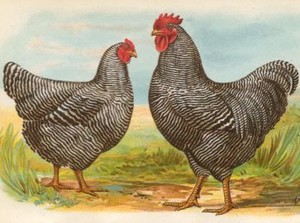
Broody
Dual Purpose
Docile |
WYANDOTTE CHICKEN BREEDS
An American breed of chicken. Wyandottes have a well-rounded body and their docile natures make them ideal backyard chickens. They lay 180-200 eggs a year, and are pretty birds to look at. There are a number of types such as black, white, silver laced, gold laced, buff, Columbian and silver-pencilled.
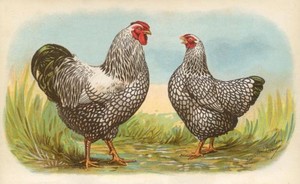
Docile
Good Choice for Novice Breeder |
Pictures courtesy of http://www.ansi.okstate.edu